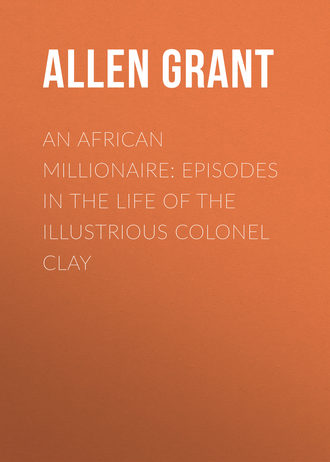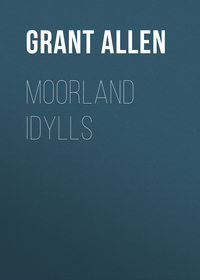 полная версия
полная версияAn African Millionaire: Episodes in the Life of the Illustrious Colonel Clay
Dr. Polperro talked a good deal after that about this valuable find. He had tried to sell it at first to the National Gallery; but though the Directors admired the work immensely, and admitted its genuineness, they regretted that the funds at their disposal this year did not permit them to acquire so important a canvas at a proper figure. South Kensington again was too poor; but the Doctor was in treaty at present with the Louvre and with Berlin. Still, it was a pity a fine work of art like that, once brought into the country, should be allowed to go out of it. Some patriotic patron of the fine arts ought to buy it for his own house, or else munificently present it to the nation.
All the time Charles said nothing. But I could feel him cogitating. He even looked behind him once, near a difficult corner (while the guard was actually engaged in tootling his horn to let passers-by know that the coach was coming), and gave Amelia a warning glance to say nothing committing, which had at once the requisite effect of sealing her mouth for the moment. It is a very unusual thing for Charles to look back while driving. I gathered from his doing so that he was inordinately anxious to possess this Rembrandt.
When we arrived at Lewes we put up our horses at the inn, and Charles ordered a lunch on his wonted scale of princely magnificence. Meanwhile we wandered, two and two, about the town and castle. I annexed Lady Belleisle, who is at least amusing. Charles drew me aside before starting. "Look here, Sey," he said, "we must be very careful. This man, Polperro, is a chance acquaintance. There's nothing an astute rogue can take one in over more easily than an Old Master. If the Rembrandt is genuine I ought to have it; if it really represents Maria Vanrenen, it's a duty I owe to the boys to buy it. But I've been done twice lately, and I won't be done a third time. We must go to work cautiously."
"You are right," I answered. "No more seers and curates!"
"If this man's an impostor," Charles went on—"and in spite of what he says about the National Gallery and so forth, we know nothing of him—the story he tells is just the sort of one such a fellow would trump up in a moment to deceive me. He could easily learn who I was—I'm a well-known figure; he knew I was in Brighton, and he may have been sitting on that glass seat on Sunday on purpose to entrap me."
"He introduced your name," I said, "and the moment he found out who I was he plunged into talk with me."
"Yes," Charles continued. "He may have learned about the portrait of Maria Vanrenen, which my grandmother always said was preserved at Gouda; and, indeed, I myself have often mentioned it, as you doubtless remember. If so, what more natural, say, for a rogue than to begin talking about the portrait in that innocent way to Amelia? If he wants a Rembrandt, I believe they can be turned out to order to any amount in Birmingham. The moral of all which is, it behoves us to be careful."
"Right you are," I answered; "and I am keeping my eye upon him."
We drove back by another road, overshadowed by beech-trees in autumnal gold. It was a delightful excursion. Dr. Polperro's heart was elated by lunch and the excellent dry Monopole. He talked amazingly. I never heard a man with a greater or more varied flow of anecdote. He had been everywhere and knew all about everybody. Amelia booked him at once for her "At Home" on Wednesday week, and he promised to introduce her to several artistic and literary celebrities.
That evening, however, about half-past seven, Charles and I strolled out together on the King's Road for a blow before dinner. We dine at eight. The air was delicious. We passed a small new hotel, very smart and exclusive, with a big bow window. There, in evening dress, lights burning and blind up, sat our friend, Dr. Polperro, with a lady facing him, young, graceful, and pretty. A bottle of champagne stood open before him. He was helping himself plentifully to hot-house grapes, and full of good humour. It was clear he and the lady were occupied in the intense enjoyment of some capital joke; for they looked queerly at one another, and burst now and again into merry peals of laughter.
I drew back. So did Sir Charles. One idea passed at once through both our minds. I murmured, "Colonel Clay!" He answered, "and Madame Picardet!"
They were not in the least like the Reverend Richard and Mrs. Brabazon. But that clinched the matter. Nor did I see a sign of the aquiline nose of the Mexican Seer. Still, I had learnt by then to discount appearances. If these were indeed the famous sharper and his wife or accomplice, we must be very careful. We were forewarned this time. Supposing he had the audacity to try a third trick of the sort upon us we had him under our thumbs. Only, we must take steps to prevent his dexterously slipping through our fingers.
"He can wriggle like an eel," said the Commissary at Nice. We both recalled those words, and laid our plans deep to prevent the man's wriggling away from us on this third occasion.
"I tell you what it is, Sey," my brother-in-law said, with impressive slowness. "This time we must deliberately lay ourselves out to be swindled. We must propose of our own accord to buy the picture, making him guarantee it in writing as a genuine Rembrandt, and taking care to tie him down by most stringent conditions. But we must seem at the same time to be unsuspicious and innocent as babes; we must swallow whole whatever lies he tells us; pay his price—nominally—by cheque for the portrait; and then, arrest him the moment the bargain is complete, with the proofs of his guilt then and there upon him. Of course, what he'll try to do will be to vanish into thin air at once, as he did at Nice and Paris; but, this time, we'll have the police in waiting and everything ready. We'll avoid precipitancy, but we'll avoid delay too. We must hold our hands off till he's actually accepted and pocketed the money; and then, we must nab him instantly, and walk him off to the local Bow Street. That's my plan of campaign. Meanwhile, we should appear all trustful innocence and confiding guilelessness."
In pursuance of this well-laid scheme, we called next day on Dr. Polperro at his hotel, and were introduced to his wife, a dainty little woman, in whom we affected not to recognise that arch Madame Picardet or that simple White Heather. The Doctor talked charmingly (as usual) about art—what a well-informed rascal he was, to be sure!—and Sir Charles expressed some interest in the supposed Rembrandt. Our new friend was delighted; we could see by his well-suppressed eagerness of tone that he knew us at once for probable purchasers. He would run up to town next day, he said, and bring down the portrait. And in effect, when Charles and I took our wonted places in the Pullman next morning, on our way up to the half-yearly meeting of Cloetedorp Golcondas, there was our Doctor, leaning back in his arm-chair as if the car belonged to him. Charles gave me an expressive look. "Does it in style," he whispered, "doesn't he? Takes it out of my five thousand; or discounts the amount he means to chouse me of with his spurious Rembrandt."
Arrived in town, we went to work at once. We set a private detective from Marvillier's to watch our friend; and from him we learned that the so-called Doctor dropped in for a picture that day at a dealer's in the West-end (I suppress the name, having a judicious fear of the law of libel ever before my eyes), a dealer who was known to be mixed up before then in several shady or disreputable transactions. Though, to be sure, my experience has been that picture dealers are—picture dealers. Horses rank first in my mind as begetters and producers of unscrupulous agents, but pictures run them a very good second. Anyhow, we found out that our distinguished art-critic picked up his Rembrandt at this dealer's shop, and came down with it in his care the same night to Brighton.
In order not to act precipitately, and so ruin our plans, we induced Dr. Polperro (what a cleverly chosen name!) to bring the Rembrandt round to the Métropole for our inspection, and to leave it with us while we got the opinion of an expert from London.
The expert came down, and gave us a full report upon the alleged Old Master. In his judgment, it was not a Rembrandt at all, but a cunningly-painted and well-begrimed modern Dutch imitation. Moreover, he showed us by documentary evidence that the real portrait of Maria Vanrenen had, as a matter of fact, been brought to England five years before, and sold to Sir J. H. Tomlinson, the well-known connoisseur, for eight thousand pounds. Dr. Polperro's picture was, therefore, at best either a replica by Rembrandt; or else, more probably, a copy by a pupil; or, most likely of all, a mere modern forgery.
We were thus well prepared to fasten our charge of criminal conspiracy upon the self-styled Doctor. But in order to make assurance still more certain, we threw out vague hints to him that the portrait of Maria Vanrenen might really be elsewhere, and even suggested in his hearing that it might not improbably have got into the hands of that omnivorous collector, Sir J. H. Tomlinson. But the vendor was proof against all such attempts to decry his goods. He had the effrontery to brush away the documentary evidence, and to declare that Sir J. H. Tomlinson (one of the most learned and astute picture-buyers in England) had been smartly imposed upon by a needy Dutch artist with a talent for forgery. The real Maria Vanrenen, he declared and swore, was the one he offered us. "Success has turned the man's head," Charles said to me, well pleased. "He thinks we will swallow any obvious lie he chooses to palm off upon us. But the bucket has come once too often to the well. This time we checkmate him." It was a mixed metaphor, I admit; but Sir Charles's tropes are not always entirely superior to criticism.
So we pretended to believe our man, and accepted his assurances. Next came the question of price. This was warmly debated, for form's sake only. Sir J. H. Tomlinson had paid eight thousand for his genuine Maria. The Doctor demanded ten thousand for his spurious one. There was really no reason why we should higgle and dispute, for Charles meant merely to give his cheque for the sum and then arrest the fellow; but, still, we thought it best for the avoidance of suspicion to make a show of resistance; and we at last beat him down to nine thousand guineas. For this amount he was to give us a written warranty that the work he sold us was a genuine Rembrandt, that it represented Maria Vanrenen of Haarlem, and that he had bought it direct, without doubt or question, from that good lady's descendants at Gouda, in Holland.
It was capitally done. We arranged the thing to perfection. We had a constable in waiting in our rooms at the Métropole, and we settled that Dr. Polperro was to call at the hotel at a certain fixed hour to sign the warranty and receive his money. A regular agreement on sound stamped paper was drawn out between us. At the appointed time the "party of the first part" came, having already given us over possession of the portrait. Charles drew a cheque for the amount agreed upon, and signed it. Then he handed it to the Doctor. Polperro just clutched at it. Meanwhile, I took up my post by the door, while two men in plain clothes, detectives from the police-station, stood as men-servants and watched the windows. We feared lest the impostor, once he had got the cheque, should dodge us somehow, as he had already done at Nice and in Paris. The moment he had pocketed his money with a smile of triumph, I advanced to him rapidly. I had in my possession a pair of handcuffs. Before he knew what was happening, I had slipped them on his wrists and secured them dexterously, while the constable stepped forward. "We have got you this time!" I cried. "We know who you are, Dr. Polperro. You are—Colonel Clay, alias Señor Antonio Herrera, alias the Reverend Richard Peploe Brabazon."
I never saw any man so astonished in my life! He was utterly flabbergasted. Charles thought he must have expected to get clear away at once, and that this prompt action on our part had taken the fellow so much by surprise as to simply unman him. He gazed about him as if he hardly realised what was happening.
"Are these two raving maniacs?" he asked at last, "or what do they mean by this nonsensical gibberish about Antonio Herrera?"
The constable laid his hand on the prisoner's shoulder.
"It's all right, my man," he said. "We've got warrants out against you. I arrest you, Edward Polperro, alias the Reverend Richard Peploe Brabazon, on a charge of obtaining money under false pretences from Sir Charles Vandrift, K.C.M.G., M.P., on his sworn information, now here subscribed to." For Charles had had the thing drawn out in readiness beforehand.
Our prisoner drew himself up. "Look here, officer," he said, in an offended tone, "there's some mistake here in this matter. I have never given an alias at any time in my life. How do you know this is really Sir Charles Vandrift? It may be a case of bullying personation. My belief is, though, they're a pair of escaped lunatics."
"We'll see about that to-morrow," the constable said, collaring him. "At present you've got to go off with me quietly to the station, where these gentlemen will enter up the charge against you."
They carried him off, protesting. Charles and I signed the charge-sheet; and the officer locked him up to await his examination next day before the magistrate.
We were half afraid even now the fellow would manage somehow to get out on bail and give us the slip in spite of everything; and, indeed, he protested in the most violent manner against the treatment to which we were subjecting "a gentleman in his position." But Charles took care to tell the police it was all right; that he was a dangerous and peculiarly slippery criminal, and that on no account must they let him go on any pretext whatever, till he had been properly examined before the magistrates.
We learned at the hotel that night, curiously enough, that there really was a Dr. Polperro, a distinguished art critic, whose name, we didn't doubt, our impostor had been assuming.
Next morning, when we reached the court, an inspector met us with a very long face. "Look here, gentlemen," he said, "I'm afraid you've committed a very serious blunder. You've made a precious bad mess of it. You've got yourselves into a scrape; and, what's worse, you've got us into one also. You were a deal too smart with your sworn information. We've made inquiries about this gentleman, and we find the account he gives of himself is perfectly correct. His name is Polperro; he's a well-known art critic and collector of pictures, employed abroad by the National Gallery. He was formerly an official in the South Kensington Museum, and he's a C.B. and LL.D., very highly respected. You've made a sad mistake, that's where it is; and you'll probably have to answer a charge of false imprisonment, in which I'm afraid you have also involved our own department."
Charles gasped with horror. "You haven't let him out," he cried, "on those absurd representations? You haven't let him slip through your hands as you did that murderer fellow?"
"Let him slip through our hands?" the inspector cried. "I only wish he would. There's no chance of that, unfortunately. He's in the court there, this moment, breathing out fire and slaughter against you both; and we're here to protect you if he should happen to fall upon you. He's been locked up all night on your mistaken affidavits, and, naturally enough, he's mad with anger."
"If you haven't let him go, I'm satisfied," Charles answered. "He's a fox for cunning. Where is he? Let me see him."
We went into the court. There we saw our prisoner conversing amicably, in the most excited way, with the magistrate (who, it seems, was a personal friend of his); and Charles at once went up and spoke to them. Dr. Polperro turned round and glared at him through his pince-nez.
"The only possible explanation of this person's extraordinary and incredible conduct," he said, "is, that he must be mad—and his secretary equally so. He made my acquaintance, unasked, on a glass seat on the King's Road; invited me to go on his coach to Lewes; volunteered to buy a valuable picture of me; and then, at the last moment, unaccountably gave me in charge on this silly and preposterous trumped-up accusation. I demand a summons for false imprisonment."
Suddenly it began to dawn upon us that the tables were turned. By degrees it came out that we had made a mistake. Dr. Polperro was really the person he represented himself to be, and had been always. His picture, we found out, was the real Maria Vanrenen, and a genuine Rembrandt, which he had merely deposited for cleaning and restoring at the suspicious dealer's. Sir J. H. Tomlinson had been imposed upon and cheated by a cunning Dutchman; his picture, though also an undoubted Rembrandt, was not the Maria, and was an inferior specimen in bad preservation. The authority we had consulted turned out to be an ignorant, self-sufficient quack. The Maria, moreover, was valued by other experts at no more than five or six thousand guineas. Charles wanted to cry off his bargain, but Dr. Polperro naturally wouldn't hear of it. The agreement was a legally binding instrument, and what passed in Charles's mind at the moment had nothing to do with the written contract. Our adversary only consented to forego the action for false imprisonment on condition that Charles inserted a printed apology in the Times, and paid him five hundred pounds compensation for damage to character. So that was the end of our well-planned attempt to arrest the swindler.
Not quite the end, however; for, of course, after this, the whole affair got by degrees into the papers. Dr. Polperro, who was a familiar person in literary and artistic society, as it turned out, brought an action against the so-called expert who had declared against the genuineness of his alleged Rembrandt, and convicted him of the grossest ignorance and misstatement. Then paragraphs got about. The World showed us up in a sarcastic article; and Truth, which has always been terribly severe upon Sir Charles and all the other South Africans, had a pungent set of verses on "High Art in Kimberley." By this means, as we suppose, the affair became known to Colonel Clay himself; for a week or two later my brother-in-law received a cheerful little note on scented paper from our persistent sharper. It was couched in these terms:—
"Oh, you innocent infant!
"Bless your ingenuous little heart! And did it believe, then, it had positively caught the redoubtable colonel? And had it ready a nice little pinch of salt to put upon his tail? And is it true its respected name is Sir Simple Simon? How heartily we have laughed, White Heather and I, at your neat little ruses! It would pay you, by the way, to take White Heather into your house for six months to instruct you in the agreeable sport of amateur detectives. Your charming naivete quite moves our envy. So you actually imagined a man of my brains would condescend to anything so flat and stale as the silly and threadbare Old Master deception! And this in the so-called nineteenth century! O sancta simplicitas! When again shall such infantile transparency be mine? When, ah, when? But never mind, dear friend. Though you didn't catch me, we shall meet before long at some delightful Philippi.
"Yours, with the profoundest respect and gratitude,
"ANTONIO HERRERA,
"Otherwise RICHARD PEPLOE BRABAZON."
Charles laid down the letter with a deep-drawn sigh. "Sey, my boy," he mused aloud, "no fortune on earth—not even mine—can go on standing it. These perpetual drains begin really to terrify me. I foresee the end. I shall die in a workhouse. What with the money he robs me of when he is Colonel Clay, and the money I waste upon him when he isn't Colonel Clay, the man is beginning to tell upon my nervous system. I shall withdraw altogether from this worrying life. I shall retire from a scheming and polluted world to some untainted spot in the fresh, pure mountains."
"You must need rest and change," I said, "when you talk like that. Let us try the Tyrol."
IV
THE EPISODE OF THE TYROLEAN CASTLE
We went to Meran. The place was practically decided for us by Amelia's French maid, who really acts on such occasions as our guide and courier.
She is such a clever girl, is Amelia's French maid. Whenever we are going anywhere, Amelia generally asks (and accepts) her advice as to choice of hotels and furnished villas. Césarine has been all over the Continent in her time; and, being Alsatian by birth, she of course speaks German as well as she speaks French, while her long residence with Amelia has made her at last almost equally at home in our native English. She is a treasure, that girl; so neat and dexterous, and not above dabbling in anything on earth she may be asked to turn her hand to. She walks the world with a needle-case in one hand and an etna in the other. She can cook an omelette on occasion, or drive a Norwegian cariole; she can sew, and knit, and make dresses, and cure a cold, and do anything else on earth you ask her. Her salads are the most savoury I ever tasted; while as for her coffee (which she prepares for us in the train on long journeys), there isn't a chef de cuisine at a West-end club to be named in the same day with her.
So, when Amelia said, in her imperious way, "Césarine, we want to go to the Tyrol—now—at once—in mid-October; where do you advise us to put up?"—Césarine answered, like a shot, "The Erzherzog Johann, of course, at Meran, for the autumn, madame."
"Is he … an archduke?" Amelia asked, a little staggered at such apparent familiarity with Imperial personages.
"Ma foi! no, madame. He is an hotel—as you would say in England, the 'Victoria' or the 'Prince of Wales's'—the most comfortable hotel in all South Tyrol; and at this time of year, naturally, you must go beyond the Alps; it begins already to be cold at Innsbruck."
So to Meran we went; and a prettier or more picturesque place, I confess, I have seldom set eyes on. A rushing torrent; high hills and mountain peaks; terraced vineyard slopes; old walls and towers; quaint, arcaded streets; a craggy waterfall; a promenade after the fashion of a German Spa; and when you lift your eyes from the ground, jagged summits of Dolomites: it was a combination such as I had never before beheld; a Rhine town plumped down among green Alpine heights, and threaded by the cool colonnades of Italy.
I approved Césarine's choice; and I was particularly glad she had pronounced for an hotel, where all is plain sailing, instead of advising a furnished villa, the arrangements for which would naturally have fallen in large part upon the shoulders of the wretched secretary. As in any case I have to do three hours' work a day, I feel that such additions to my normal burden may well be spared me. I tipped Césarine half a sovereign, in fact, for her judicious choice. Césarine glanced at it on her palm in her mysterious, curious, half-smiling way, and pocketed it at once with a "Merci, monsieur!" that had a touch of contempt in it. I always fancy Césarine has large ideas of her own on the subject of tipping, and thinks very small beer of the modest sums a mere secretary can alone afford to bestow upon her.
The great peculiarity of Meran is the number of schlosses (I believe my plural is strictly irregular, but very convenient to English ears) which you can see in every direction from its outskirts. A statistical eye, it is supposed, can count no fewer than forty of these picturesque, ramshackled old castles from a point on the Küchelberg. For myself, I hate statistics (except as an element in financial prospectuses), and I really don't know how many ruinous piles Isabel and Amelia counted under Césarine's guidance; but I remember that most of them were quaint and beautiful, and that their variety of architecture seemed positively bewildering. One would be square, with funny little turrets stuck out at each angle; while another would rejoice in a big round keep, and spread on either side long, ivy-clad walls and delightful bastions. Charles was immensely taken with them. He loves the picturesque, and has a poet hidden in that financial soul of his. (Very effectually hidden, though, I am ready to grant you.) From the moment he came he felt at once he would love to possess a castle of his own among these romantic mountains. "Seldon!" he exclaimed contemptuously. "They call Seldon a castle! But you and I know very well, Sey, it was built in 1860, with sham antique stones, for Macpherson of Seldon, at market rates, by Cubitt and Co., worshipful contractors of London. Macpherson charged me for that sham antiquity a preposterous price, at which one ought to procure a real ancestral mansion. Now, these castles are real. They are hoary with antiquity. Schloss Tyrol is Romanesque—tenth or eleventh century." (He had been reading it up in Baedeker.) "That's the sort of place for me!—tenth or eleventh century. I could live here, remote from stocks and shares, for ever; and in these sequestered glens, recollect, Sey, my boy, there are no Colonel Clays, and no arch Madame Picardets!"









